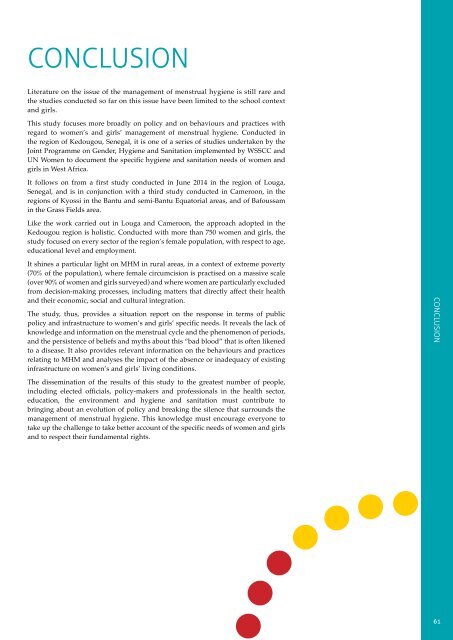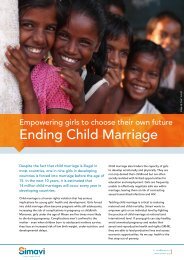1wE4FuZ
1wE4FuZ
1wE4FuZ
Create successful ePaper yourself
Turn your PDF publications into a flip-book with our unique Google optimized e-Paper software.
ConclusionLiterature on the issue of the management of menstrual hygiene is still rare andthe studies conducted so far on this issue have been limited to the school contextand girls.This study focuses more broadly on policy and on behaviours and practices withregard to women’s and girls’ management of menstrual hygiene. Conducted inthe region of Kedougou, Senegal, it is one of a series of studies undertaken by theJoint Programme on Gender, Hygiene and Sanitation implemented by WSSCC andUN Women to document the specific hygiene and sanitation needs of women andgirls in West Africa.It follows on from a first study conducted in June 2014 in the region of Louga,Senegal, and is in conjunction with a third study conducted in Cameroon, in theregions of Kyossi in the Bantu and semi-Bantu Equatorial areas, and of Bafoussamin the Grass Fields area.Like the work carried out in Louga and Cameroon, the approach adopted in theKedougou region is holistic. Conducted with more than 750 women and girls, thestudy focused on every sector of the region’s female population, with respect to age,educational level and employment.It shines a particular light on MHM in rural areas, in a context of extreme poverty(70% of the population), where female circumcision is practised on a massive scale(over 90% of women and girls surveyed) and where women are particularly excludedfrom decision-making processes, including matters that directly affect their healthand their economic, social and cultural integration.The study, thus, provides a situation report on the response in terms of publicpolicy and infrastructure to women’s and girls’ specific needs. It reveals the lack ofknowledge and information on the menstrual cycle and the phenomenon of periods,and the persistence of beliefs and myths about this “bad blood” that is often likenedto a disease. It also provides relevant information on the behaviours and practicesrelating to MHM and analyses the impact of the absence or inadequacy of existinginfrastructure on women’s and girls’ living conditions.ConclusionThe dissemination of the results of this study to the greatest number of people,including elected officials, policy-makers and professionals in the health sector,education, the environment and hygiene and sanitation must contribute tobringing about an evolution of policy and breaking the silence that surrounds themanagement of menstrual hygiene. This knowledge must encourage everyone totake up the challenge to take better account of the specific needs of women and girlsand to respect their fundamental rights.61



